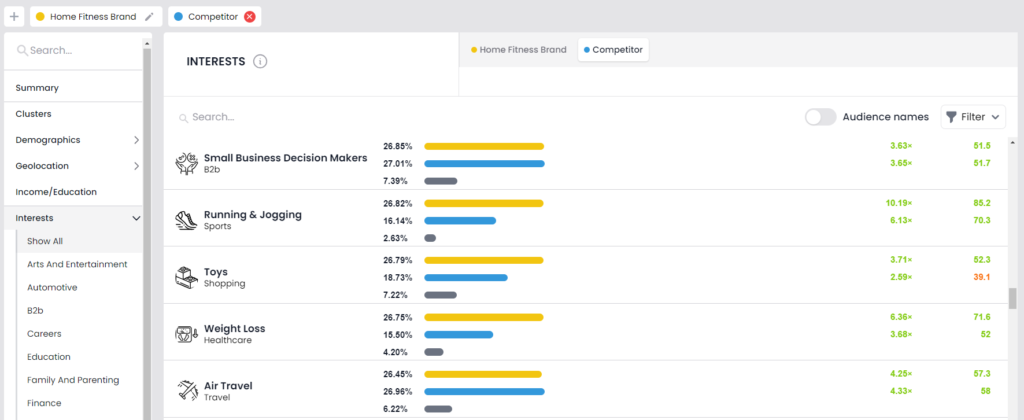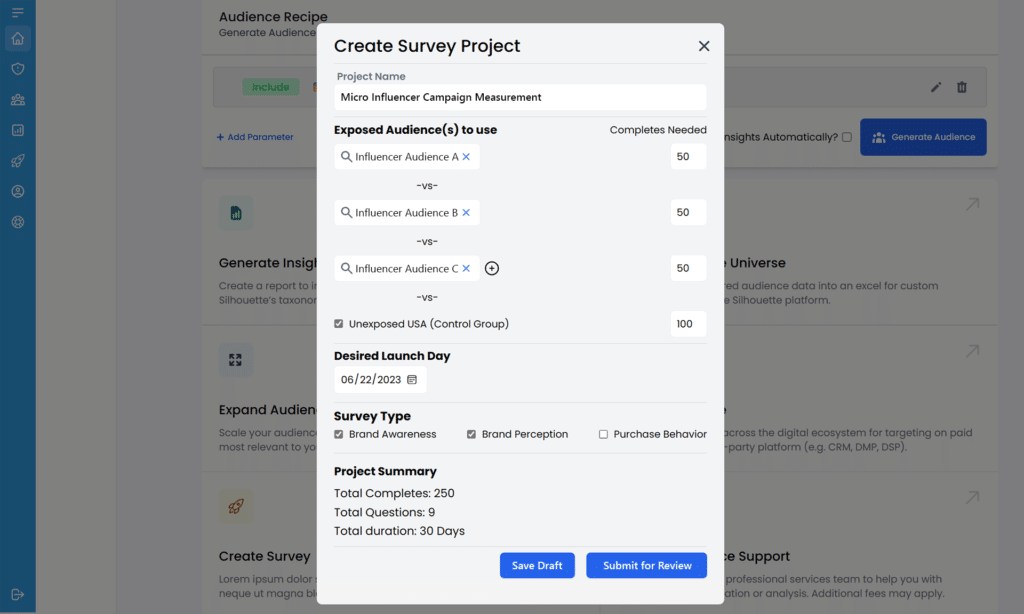Understanding your audience’s unique interests, affinities, and preferences is a nearly impossible task, requiring marketers to piece together data from various sources, tactics, and even departments. In this blog, we’ll explore the most common data sources and strategies you might already be employing to better understand your prospects and customers. More importantly, we introduce how StatSocial’s leading audience intelligence platform is transforming the way marketers draw these critical consumer insights to craft and refine winning go-to-market strategies.
Exploring the Top 5 Data Sources and Tactics for Audience Insights: Advantages and Limitations
1. CRM and purchase data
Leveraging your CRM and purchase data is a great first step in understanding your audience. This data often includes insights from the buyer’s journey, purchase behavior, and product usage, providing a foundational layer of consumer research.
In many cases, the data that marketers have on existing customers can be fairly limited or fragmented across disconnected systems and organizational silos. Additionally, while the data might offer a surface-level view of demographics and purchase history, it often falls short in delivering the depth of behavioral insights required for truly data-driven programs. The key lies in integrating first-party data sources with quality third-party datasets to enrich your understanding and effectively segment key customer groups.
2. Survey
Online surveys are a great resource for marketers to learn more about their target audience—their unique preferences and buyer motivations—to fill in data gaps and create a more seamless buying experience. Thanks to the large amount of online survey tools available, they’re also fairly easy to implement.
Unfortunately, reaching the right consumers often requires casting a wide net which is a drain on time and resources. And even when you are able to garner relevant responses, the scope of insights derived from these questionnaires are inherently limited.
3. Online and in-person focus groups
Online and in-person focus groups have been a trusted staple in the marketing industry—providing a wealth of knowledge directly from the source. The best focus groups should represent your target audience and include a mix of current customers and potential first-time buyers. It’s a great way to test out a new product idea or validate your current go-to-market strategy.
For many fast moving companies, the time and resources it takes to conduct an effective focus group can put it out of the question. If your company hosts or attends any industry events, reach out to attendees ahead of time to ask if they would be willing to participate in a one-on-one interview or focus group before, during, or after the event (offering a free coffee or meal in exchange can help drive further participation).
4. Brand communities and forums
A great alternative to focus groups are online communities and forums that your target audience frequents, such as Reddit, Facebook, or even brand-owned communities. These forums can provide a wealth of knowledge when it comes to figuring out your target audience’s preferences, as well as how they feel about your current and future product offerings.
Depending on the industry in which you belong, some forums or communities can take more time and effort to develop. For example, people tend to post frequently about certain topics (e.g. fashion), naturally forming communities without brand intervention. Marketers in more niche markets may determine they need to actively recruit members to brand communities or even offer incentives so that buyers will share their opinions and thoughts with like-minded individuals.
5. Social Listening
Social listening is invaluable at keeping you in the know. You can get a deeper understanding of brand mentions and the sentiment surrounding your brand at any point by tapping into social discussions. It also helps you to keep a close eye on competitors and any trending topics or conversations relevant to your market.
While social listening is a must-have for many, it does fall short when it comes to understanding the audiences behind the conversation. Luckily, we will be covering how combining social listening platforms with other consumer insights tools can result in the ability to monitor only those audiences most relevant to your brand.
While all of these data sources and tactics have their merits, they do also have drawbacks, leading to more questions than answers. But there is a resource too many marketers aren’t leveraging, and that’s social audience insights tools.
How to better understand your consumers with StatSocial’s audience intelligence platform
The typical consumer spends several hours a day on their favorite social platforms, leading to endless amounts of user generated insights you can harness, but only if you have the right tool.
StatSocial’s social audience insights platform enables you to create and analyze any audience to uncover their unique interests, brand loyalties, trusted influencers, and media preferences, from mainstream channels to niche podcasts.
In just minutes, StatSocial captures the crucial audience data you need to not only better understand any consumer, brand, or social audience, but to take action easily and strategically.
Here are just a few examples of the unique audiences you can gain insights on, or even compare within the platform:
- Specific consumer groups (e.g. executives that are also parents)
- Brand audiences
- Fans of specific media (e.g. TV shows, magazine, podcasts, radio etc)
- Influencer followers (e.g. macro, micro, nano)
- Various demographic groups
How to take action on audience intelligence with StatSocial’s platform
Once you have StatSocial’s self-declared data at your fingertips, the sky’s the limit on what you can do with it. Here are 6 different ways you can start putting StatSocial’s audience intelligence to work for you.
1. Competitor research
Understanding your audience and what matters to them is crucial when connecting with them. The same goes for your competitor’s audience. In StatSocial’s platform, you can create custom brand audiences to compare to one another, or to a specific competitor’s audience. In a single view, dive into key similarities and differences to inform your overall go-to-market strategy.

2. Consumer-based research
StatSocial offers the ability to analyze custom audiences as well as both first and third-party datasets, including those from your CRM, paid campaigns, or survey panels. This ensures that regardless of the data sources at your disposal, you can attain a holistic view of your audience for more informed decision-making.

3. Media planning
Media kits and engagement rates are great starting points for determining where to spend your ad dollars; however StatSocial enables you to take an audience-first approach, by identifying the media channels your audience actually engages with, from traditional media outlets to niche podcasts. You can not only gain valuable media insights but target your audience or any custom audience across the digital ecosystem from paid to CTV.

4. Influencer marketing
Influencer marketing is all the rage right now. But in haste to try and capitalize on these campaigns, too many marketers aren’t doing their due diligence around identifying the best influencers for their audience and accurately calculating the impact of their campaigns. With StatSocial’s platform, you can easily accomplish both by seeing which influencers your audience engages with most in addition to tracking changes in brand health pre and post-campaign.

5. Brand measurement
Whether you’re trying to weather the storm during a PR crisis or just trying to understand how your brand is perceived after a new campaign or product launch, monitoring the health of your brand is essential. With StatSocial, you can easily identify and survey audiences organically exposed to your most recent marketing campaign for an accurate measurement of brand lift, or keep an eye on overall brand health with our “always-on” tracking feature.

6. Social panel creation & monitoring
With StatSocial’s platform, you can create and export custom audiences to your preferred social listening platform to monitor ongoing trends and conversations relevant to your brand. You can also import social IDs into StatSocial to analyze specific audiences behind the conversation.
Discover your next data partner
StatSocial’s platform isn’t just another tool; it’s a transformative solution for navigating the complexities of understanding and reaching your audience. But don’t just take our word for it— check out a few of our sample reports to see the volume of insights available for any audience.
If you’re considering adoption of an audience intelligence platform, we encourage you to schedule a personalized demo of StatSocial’s platform with a member of our team, or check out the following resources to learn more:
> The Truth About Audience Intelligence Platforms
> Discover Audience Intelligence Platforms on G2